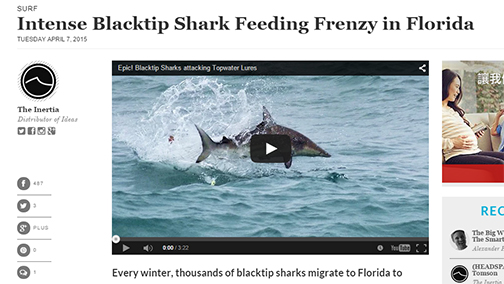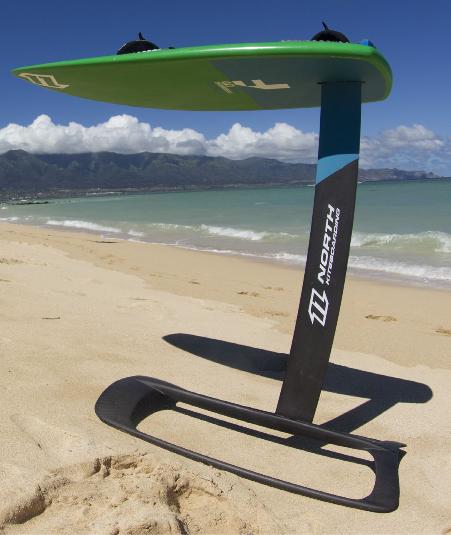 |
|
|
previous topic :: next topic |
| Author |
Message |
J.P.

Since 10 Mar 2005
638 Posts
Addicted
|
 Thu Apr 09, 15 6:50 am Foil theory 101 Thu Apr 09, 15 6:50 am Foil theory 101 |
 |
|
Stolen shamelessly from Kite forum
There is some discusses about the positive lift stabilizator,
I tried with DWB to translate to english, sorry for the faults but the principle is here:
ZEEKO lift down stabilizer info
Negative profile for the stabilizer.
Hello everyone,
here is a short explanation of our choice negative profile for the stabilizer.
Indeed, as you know the stabilizer is a masterpiece in the behavior of a foil.
To show you the benefits of a negative lift profile for the stabilizer it is first necessary to study the interest of the stabilizer.
Aircraft or foil, can fly without stabilizers: we saw some video showing hydrofoil riders without stab. However, it is really difficult to ride without because it amounts to ride like the picture below:
See 3 axis Image
The first problems that appear during learning of hydrofoil are pitching problems.
Pitching is defined as below:
Indeed, porpoising (yoyo up and down in foil) is a problem related to the mismanagement of the pitching from the rider.
This problem has two consequences:
1- a performance loss: a foil is highly efficient if it oscillates only slightly in pitch, once more he has to pitch oscillations and there is energy loss as increase drag
2- a total loss of control of the foil. When you are beginner, you create a lot of variations in term of pitch of the foil. This results is in large variations lift the foil.
How do we manage these impacts variations and thus lift: by moving our own center of gravity above the foil.
This pitching problem is a problem for beginners but also a problem for the experts. Indeed, we see it during competition, some riders with foil have a lack of pitch control of the foil (they explode in flight as we say, from personal experience in competition, when you are head to head it is not funny when one when you cannot control anymore the pitch of your hydrofoil because your reaction time is not quick enough to control the altitude of the hydrofoil).
So we have a problem which is a problem for beginners AND for experts.
Experts are not limited by the performance of their foil but mainly by the management pitching it (apart from a handful of riders on the planet).
What I see in the foil is that:
- Everyone does not want the same Yaw effect for a foil:
For this, we give the possibility for each rider to change his yaw effect by changing the size of the vertical rear fin of the foil in 2015.
- Everyone wants a controlled roll:
for that length of the mat is very important. Thus it is advantageous to change the length of the mat. Over the mat is longer and the management of the roll is important. This is not the only factor but it contributes greatly. If necessary I will return it.
But mostly everyone wants a stable foil pitch because it makes the predictable behavior for the foil (except of course those who want challenges).
How to limit the pitch of a foil without changing the front wing : using a stabilizer.
Now that the interest of the stabilizer is well established, then it must be asked what type of stabilizer interme of lift : Positive/ neutral / Negative .
I will not go into the Angle of attache (AoA) of the stabilizers because ultimately a stabilizer is taking into account their profile AND its angle of incidence and creates just very positive, a positive , neutral, negative very negative spoiler spoiler.
A positive stabilizer allows a stabilizer that creates lift up as the front wing of the foil (all fins lift the rider). So the center of Lift (taking in account the lift created by the front wing and the stabilizator) is between the front wing and stabilizer (see the diagram below (top left):
Positive negative lift Image
This type of profile can increase the performance of a foil, but also has a great ability to change the balance of the foil when your ride change a lot the overall angle of Attack (lift up and down as beginners for example). Indeed, if the incidence angle increases foil (bottom left diagram), then lift of the stabilizer increases very quickly. One feels a big amount of lift made by the hydrofoil (for when the foil up, the center of gravity moove backward, and moved backward the center of lift of the foil).
To prevent this phenomenon without changing the setting, you must:
either ride as close to the surface of the water, where the water creates less pressure on the wings (more wings are deep in the water and more the water creates pressure on the wings and therefore increases the lift ). This can cause problems on choppy waters
Either you should moove frontward your center of gravity or push more strongly with the front leg to move frontward the center of gravity, it's an endless management.
On the other side as and as the speed increases, so it has more lift upwardly related stabilizer, it induces naturally that the foil lift down by a misalignment of the center of lift of the hydrofoil and point and total center of gravity, the latter now being too forward).
Also the faster we go, the more it is necessary to change the A0A of the stabilizer to make it less lift. The perfect world should be with a change of the AoA during the ride, it is what a moth foiler do but has an otherwise complicated system set up, it is not our case.
Another consequence of a positive lift stabilizer: for the same foil with a positive stabilizer, the center of lift the foil is backward. Therefore equivalent foil, the rider must be further back on his board. For making the test on my foil (I can ride my stabilizer positive of negative without problems), I have my feet back more than 10cm on my board with a hydrofoil with a positive lift stabilizer compare to a negative lift stabilizer. This is not a problem, but just a statement to be considered according to what is desired.
Thus, the positive profile on the stabilizer can be problematic, especially in terms of feeling as it leads to a constant control of the alignement of the Center of lift and the center of gravity. Faster I am and backward I need to be on the board.
How to remove this:
We have a second possibility: to create a negative lift stabilizer.
It is our choice. Why this choice?
Just because we are looking for a automtaic pitch control.
With negative lift stabilizer, the center of lift of the foil is frontward the front wing (see top right figure), but especially when the foil is with a positive AoA (the board lift up for example), then the stabilizer creates less lift as inversely to the front wing, the variation of the angle of incidence is negative (see bottom right picture). Therefore, it tempers the extra lift of the front wing. Indeed, he mooved back the center of lift of the foil at the time whenthe center of gravity also moving backwards, everything works together is harmony!
All the work of the designer is to create profiles that allow a constant alignment of the center of lift and center of gravity.
On the other hand, when the foil lift down, so naturally, the negative stabilizer creates more lift down, and therefore naturally helps lift up the nose of the foil, so take off the board.
At this property is added, the fact that changes of lift of a a negative lift stabilizator are much more linear (less violent) that variations positive lift stabilizator, because we are on incidence angles generally lower
Therefore, the question that may arise is finally to have the best of both worlds do not you need a neutral stabilizator?
According to all the tests I have done for over 6 years, a symmetrical stabilizer with the same angle of atatck as the front wing create same problem as a positive lift stabilizator. Therefore in general, and I think this is the case for everyone here, it puts a negative angle of a few degrees on the stabilizer relative to the front wing. Basically, when a front wing is stalled at 0 ° to the axis of the fuselage, while the stabilizer is rigged to -2 ° (this is an example).
But according to our tests in numerical wind tunnel, a negative lift profile at an angle of 0 ° can create the same lift a symmetrical wing stalled at -2 °. But mostly, this value is gained with a large reduction in drag, this is why asymmetric profiles are more efficient. For the beginner there is no big difference but for some expert it is a world apart.
Also the effect of the negative lift stabilizator has another great feature:
As we have seen its lift changes according to the angle of incidence, but also it allows to be used at all speeds without the changing the location of the center of gravity. That is to say that the behavior of a foil is the same high or low speed. That is why our foils are delivered without trimming of the stabilizator according to the speed required by the rider.
In waves or speed, the negative lift stabilizator does not need adjusting to fit, it adapts itself on both its intrinsic qualities.
Finally, depending on the speed of ride, the balance of front and back leg pressure is stable, and is not a function of the speed: the foil center o f lift is always aligned to the center of gravity, it makes the feel of a stable hydrofoil at any speed: at 30kt or 15knots speed you push the same on the front and the back leg (proportionally course).
I hope I was clear. For us our goal was to minimize pitching effect of the hydrofoil because it is a parameter that is harmful to the control of foil.
To have a perfect control of the pitch, you need a negative lift stabilizator.
Ride easy
Nicolas
http://zeeko-kites.com/fr/
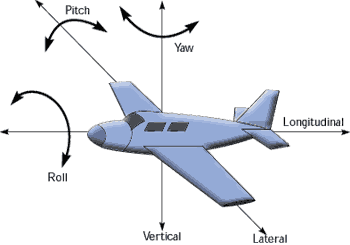 |
| |
3axis.gif |
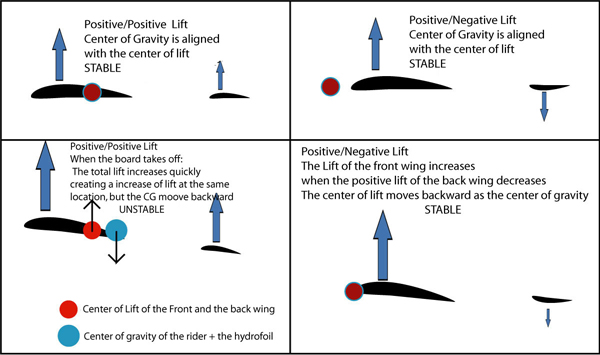 |
| |
PositiveNegativeLift_Zeeko.jpg |
_________________
John
UPWIND LAUNCH OF A SPORT
|
|
|
Mark

Since 20 Jun 2005
3679 Posts
I need my fix because I'm a
Naishaholic
|
 Thu Apr 09, 15 7:24 am Thu Apr 09, 15 7:24 am |
 |
|

_________________
Cleverly disguised as an adult...
www.naishkites.com |
|
|
Nak

Since 19 May 2005
4318 Posts
Camas
Site Lackey
CGKA Member
|
 Thu Apr 09, 15 8:27 am Thu Apr 09, 15 8:27 am |
 |
|
Interesting discussion. However, the diagrams have a small but critical error. Looking at both the wing and stabilizer, the diagram seems to show that direction of lift is controlled by the shape of the foil--i.e. the curved surface on top of the foil creates lift up and the curved surface on the bottom of the stabilizer creates lift in the down direction. This could lead designers unfamiliar with lift theory to create flawed setups. The author can be forgiven for this mistake because even many textbooks still get this wrong. The curved surface does NOT dictate direction of lift. The old--incorrect--theory: fluid traveling over the curved surface travels further so it must travel faster than fluid on the straight surface. The higher velocity causes a drop in pressure which creates lift. This sounds reasonable, but in fact is incorrect. How do you suppose planes can fly upside down?
To create a negative lift stabilizer, the stabilizer must have a negative Angle Of Attack. If the angle of attack of the stabilizer is the same as the foil, it will produce lift in the same direction as the foil--regardless of the curvature of either surface. The diagram shows both surfaces with the same angle of attack. To create a negative lift stabilizer the stabilizer would have to be canted so that the front points slightly down.
NASA has a great page that explains this in reasonably simple terms. Correct theory is on the first page, incorrect theories are explained on successive pages.
http://www.grc.nasa.gov/WWW/K-12/airplane/right2.html
|
|
|
J.P.

Since 10 Mar 2005
638 Posts
Addicted
|
 Thu Apr 09, 15 9:15 am Thu Apr 09, 15 9:15 am |
 |
|
One take away I get from the Zeeko's article is that there is no right or wrong method in this application, there are many ways to “skin this cat”.
As stated, all three methods will work, yet will perform differently.
When one takes a closer look at the approach the 12+, manufactures have taken on this design point, you’ll see they all over the board, some are neutral some are positive and all of the fast race set ups seen this year in LaVentana are negative.
I would hope this leads to the obvious question, what are the riding characteristics that you desire?
_________________
John
UPWIND LAUNCH OF A SPORT
|
|
|
J.P.

Since 10 Mar 2005
638 Posts
Addicted
|
 Thu Apr 09, 15 9:24 am Thu Apr 09, 15 9:24 am |
 |
|
| Nak wrote: | | Interesting discussion. However, the diagrams have a small but critical error. Looking at both the wing and stabilizer, the diagram seems to show that direction of lift is controlled by the shape of the foil |
| Nak wrote: |
To create a negative lift stabilizer, the stabilizer must have a negative Angle Of Attack. If the angle of attack of the stabilizer is the same as the foil, it will produce lift in the same direction as the foil--regardless of the curvature of either surface. The diagram shows both surfaces with the same angle of attack. To create a negative lift stabilizer the stabilizer would have to be canted so that the front points slightly down.
|
I can tell you with 100% confidence that my Spotz v1, and Radvance’s Spotz v2 have a rear stabilizer that create negative lift thru it's shape, our rear horizontal-stabs are concaved on the top and convex on the bottom. I have not checked it's "trim AOA" with regards to the front foil yet, but will tonight.
On today’s commercial aircraft the rear stabs are neutral-ish in shape and lift they produce is control by the pilot s trim on the stick. Aircraft require flexibly on this point due to the ever changing pay-loads (every flight is different) and resulting shifts in its CG.
_________________
John
UPWIND LAUNCH OF A SPORT
Last edited by J.P. on Thu Apr 09, 15 9:42 am; edited 3 times in total |
|
|
J.P.

Since 10 Mar 2005
638 Posts
Addicted
|
 Thu Apr 09, 15 9:33 am Thu Apr 09, 15 9:33 am |
 |
|
Many, many ways, to "skin this cat"
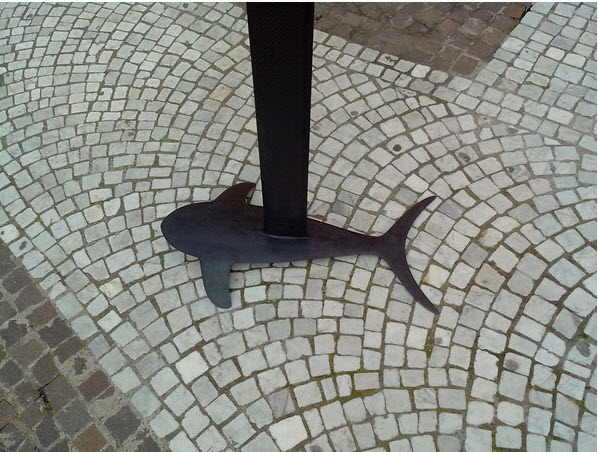 |
| |
skinnedCat.jpg |
_________________
John
UPWIND LAUNCH OF A SPORT
|
|
|
C Johnson

Since 17 Apr 2009
854 Posts
Seattle
Opinionated
|
|
|
Gman

Since 11 Feb 2006
4911 Posts
Portland
Unstrapped
|
|
|
J.P.

Since 10 Mar 2005
638 Posts
Addicted
|
|
|
Nak

Since 19 May 2005
4318 Posts
Camas
Site Lackey
CGKA Member
|
 Thu Apr 09, 15 10:09 pm Thu Apr 09, 15 10:09 pm |
 |
|
| J.P. wrote: | | On today’s commercial aircraft the rear stabs are neutral-ish in shape and lift they produce is control by the pilot s trim on the stick. Aircraft require flexibly on this point due to the ever changing pay-loads (every flight is different) and resulting shifts in its CG. |
I might know a tiny bit about modern commercial aircraft... 
| J.P. wrote: |
I can tell you with 100% confidence that my Spotz v1, and Radvance’s Spotz v2 have a rear stabilizer that create negative lift thru it's shape, our rear horizontal-stabs are concaved on the top and convex on the bottom. I have not checked it's "trim AOA" with regards to the front foil yet, but will tonight. |
Unless you're using a very thick stabilizer, it's shape is going to have a very minor effect on direction of lift. Look at the included picture; that will show you basically how shape will affect your AOA. Since most foils are very thin, the shape is only going to move the chord line a tiny bit. This difference in AOA is insignificant compared to the AOA changes you make riding the board. Will it have an effect? Certainly.Will it be tiny? Yes.
I'm not saying your boards aren't very stable; I'm sure they are. I am saying your reasoning for why they are stable is flawed. This isn't just me talking, the theory of lift you are using has very long since been debunked. Read the link to the paper by NASA. Talk to any aeronautical engineer. Many schools and text books--not engineering schools or books-- still wrongly teach the theory you've outlined, so your position is entirely understandable.
I promise you that the camber you have on your foils is not sufficient to create enough lift without a few degrees of positive pitch. That pitch is more than offsetting the camber you have on your stabilizer. If the small camber on your stabilizer is the only variation between it and the foil, then your stabilizer is producing positive lift in stabilized flight. That's not my opinion, that is simple fact. Don't take my word for it, just research it. When you understand lift theories better, you'll be able to make boards even better than what you have now.
Now, if you are using a very thick stabilizer then what you outline could in fact be correct. I've just never seen a stabilizer thick enough to make that big a difference.
Could what you've done with the shape of your stabilizer have made your setup more stable? Certainly it could!! Just not for the reasons you've specified.
 |
| |
Airfoil_angle_of_attack.jpg |
|
|
|
J.P.

Since 10 Mar 2005
638 Posts
Addicted
|
|
|
Nak

Since 19 May 2005
4318 Posts
Camas
Site Lackey
CGKA Member
|
 Fri Apr 10, 15 8:08 am Fri Apr 10, 15 8:08 am |
 |
|
I currently fly the A330. I'm also qualified on the EC-135(B707), B727, B747, DC9, A320, DC-10, T-37 and the T-38. I took Aeronautical/Mechanical Engineering at Oregon State. OSU did not offer an Aeronautical Engineering degree, but did offer coursework that allowed Mechanical Engineering majors to concentrate on aeronautics. (I should note that I did not finish my engineering degree. In my senior year the USAF was fat on pilots and short on engineers. Had I not left engineering, the AF most likely would have made me an engineer and not a pilot.) I've also been known to turn a wrench or two and dabble in design work. In the course of my AF and commercial flying, I've been lucky to have been able to interact with both maintenance and design engineers from Boeing and Airbus.
Anyways, I hope you realize I'm not putting down you or your boards. I have nothing but the greatest respect for anyone who builds and designs anything, especially cutting edge stuff like foils. It's just that lift theory is so widely misunderstood; I can't help but think that understanding current lift theory would help advance foil design--resulting in even better gear.
|
|
|
stringy

Since 23 Jun 2006
1739 Posts
vancouver
XTreme Poster
|
 Fri Apr 10, 15 8:18 am Fri Apr 10, 15 8:18 am |
 |
|
this thread has way too much text...
and let's stop the pissing contest before it starts
_________________
www.jimstringfellow.com |
|
|
Nak

Since 19 May 2005
4318 Posts
Camas
Site Lackey
CGKA Member
|
 Fri Apr 10, 15 8:18 am Fri Apr 10, 15 8:18 am |
 |
|
| I'm curious, has anyone tried raising or lowering the stabilizer? Without tunnel work, it's impossible to know how turbulence from the foil is affecting the stabilizer. Putting the stabilizer on a different plane from the foil might have pretty drastic results. No way of knowing without either experimentation or tunnel work.
|
|
|
Pepi

Since 16 Jun 2006
1832 Posts
Pure Stoke Sports
Shop Owner
CGKA Member
|
|
|
Nak

Since 19 May 2005
4318 Posts
Camas
Site Lackey
CGKA Member
|
 Fri Apr 10, 15 8:36 am Fri Apr 10, 15 8:36 am |
 |
|
| Sorry if I came off that way, I certainly didn't mean to. I just get very matter of fact when discussing tech. I take no offense at anything in a tech discussion and forget that my matter of fact attitude can rub the wrong way in a tech discussion. I apologize to all, and especially to J.P., for my social ineptness in this arena.
|
|
|
J.P.

Since 10 Mar 2005
638 Posts
Addicted
|
 Fri Apr 10, 15 8:51 am Fri Apr 10, 15 8:51 am |
 |
|
| Nak wrote: | | I apologize to all, and especially to J.P., for my social ineptness in this arena. |
Nak,
No WORRIES!!!! We're are very much brothers in arms when it comes to this affliction!!!
When you see me at Rufus at in the near future, please introduce yourself and I'll the buy the first couple rounds!
Good winds to you!
John
_________________
John
UPWIND LAUNCH OF A SPORT
Last edited by J.P. on Fri Apr 10, 15 9:19 am; edited 2 times in total |
|
|
|
|
You cannot post new topics in this forum
You cannot reply to topics in this forum
You cannot edit your posts in this forum
You cannot delete your posts in this forum
You cannot vote in polls in this forum
You can attach files in this forum
You can download files in this forum
|
|






